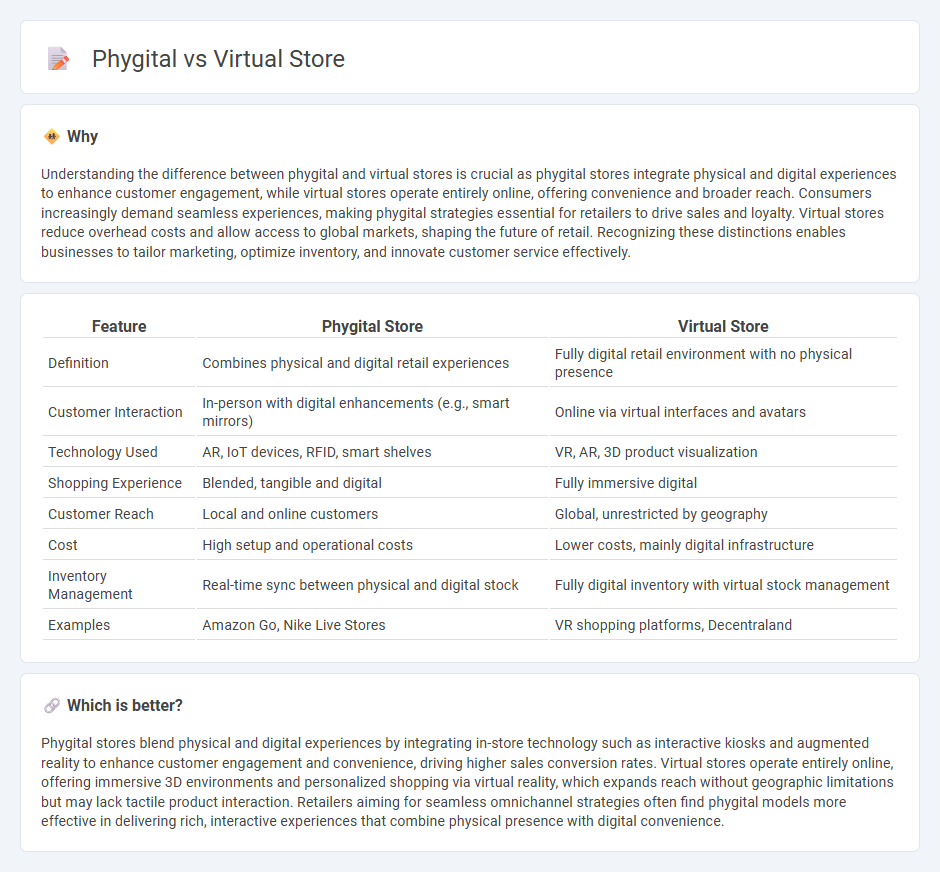
Phygital stores combine physical and digital shopping experiences by integrating in-store technology with online convenience, enhancing customer engagement and personalization. Virtual stores operate entirely online, offering immersive and interactive environments through augmented reality and 3D simulations to replicate in-store browsing. Explore how these innovative retail models transform consumer behavior and business strategies.
Why it is important
Understanding the difference between phygital and virtual stores is crucial as phygital stores integrate physical and digital experiences to enhance customer engagement, while virtual stores operate entirely online, offering convenience and broader reach. Consumers increasingly demand seamless experiences, making phygital strategies essential for retailers to drive sales and loyalty. Virtual stores reduce overhead costs and allow access to global markets, shaping the future of retail. Recognizing these distinctions enables businesses to tailor marketing, optimize inventory, and innovate customer service effectively.
Comparison Table
| Feature | Phygital Store | Virtual Store |
|---|---|---|
| Definition | Combines physical and digital retail experiences | Fully digital retail environment with no physical presence |
| Customer Interaction | In-person with digital enhancements (e.g., smart mirrors) | Online via virtual interfaces and avatars |
| Technology Used | AR, IoT devices, RFID, smart shelves | VR, AR, 3D product visualization |
| Shopping Experience | Blended, tangible and digital | Fully immersive digital |
| Customer Reach | Local and online customers | Global, unrestricted by geography |
| Cost | High setup and operational costs | Lower costs, mainly digital infrastructure |
| Inventory Management | Real-time sync between physical and digital stock | Fully digital inventory with virtual stock management |
| Examples | Amazon Go, Nike Live Stores | VR shopping platforms, Decentraland |
Which is better?
Phygital stores blend physical and digital experiences by integrating in-store technology such as interactive kiosks and augmented reality to enhance customer engagement and convenience, driving higher sales conversion rates. Virtual stores operate entirely online, offering immersive 3D environments and personalized shopping via virtual reality, which expands reach without geographic limitations but may lack tactile product interaction. Retailers aiming for seamless omnichannel strategies often find phygital models more effective in delivering rich, interactive experiences that combine physical presence with digital convenience.
Connection
Phygital and virtual stores merge physical retail experiences with digital technology, enhancing customer engagement and personalized shopping. Augmented reality (AR), QR codes, and mobile apps bridge in-store and online interactions, enabling seamless browsing and purchasing. Data analytics from both platforms drive targeted marketing and inventory optimization, improving overall retail performance.
Key Terms
Omnichannel
Virtual stores offer seamless online shopping experiences with extensive product variety, real-time inventory updates, and personalized digital interactions, leveraging AI and data analytics for customer engagement. Phygital stores integrate physical and digital touchpoints, combining in-store experiences with online convenience through technologies like AR, QR codes, and mobile apps to create a unified OmniChannel approach. Explore how these models redefine retail strategies to boost customer loyalty and drive sales growth.
Customer Experience
Virtual stores offer immersive digital environments where customers interact with products through augmented reality and personalized AI-driven recommendations, enhancing convenience and engagement. Phygital experiences combine physical retail elements with digital technologies, enabling seamless integration of tactile shopping with real-time data insights and omnichannel support for a holistic customer journey. Explore how these innovative retail models transform customer experience and drive business growth.
Digital Integration
Virtual stores leverage immersive digital environments to deliver seamless shopping experiences without physical locations, utilizing augmented reality and AI-driven personalization for enhanced customer engagement. Phygital retail integrates digital technologies such as IoT sensors and mobile apps within physical stores to create interactive, data-driven shopping experiences that blend online and offline advantages. Explore how advanced digital integration transforms retail landscapes by bridging virtual convenience and tangible interaction.
Source and External Links
What Is a Virtual Store? A Guide to Immersive Shopping - Fourthwall - A virtual store is an online shopping experience that simulates physical stores, offering larger product selections without physical space limits, 24/7 accessibility, lower overhead costs, and immersive 3D environments often compatible with VR technology.
Virtual stores: How does it work, types, examples & future trends - Virtual stores create a digital replica of physical retail spaces, using technologies like virtual reality and 3D modeling to provide interactive, immersive shopping experiences with personalized AI-driven product recommendations.
5 Examples of 3D Virtual Stores And Why They're So Exciting - 3D virtual stores blend e-commerce with VR and AR to create immersive environments where shoppers can explore and interact with products as if physically present, exemplified by Burberry's virtual flagship store offering interactive styling tips and global access.
 dowidth.com
dowidth.com